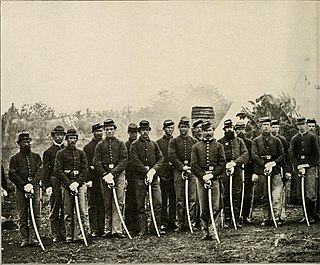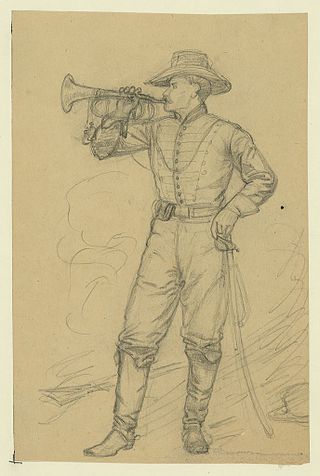
David McMurtrie Gregg was an American farmer, diplomat, and a Union cavalry general in the American Civil War.

Theophilus Francis Rodenbough was born in Easton, Pennsylvania and was a Union Army officer during the American Civil War. He received America's highest military decoration the Medal of Honor for his actions at the Battle of Trevilian Station. After his retirement from the U.S. Army in 1870, he wrote several books about military history.

During the American Civil War, the Commonwealth of Pennsylvania played a critical role in the Union, providing a substantial supply of military personnel, equipment, and leadership to the Federal government. The state raised over 360,000 soldiers for the Federal armies. It served as a significant source of artillery guns, small arms, ammunition, armor for the new revolutionary style of ironclad types of gunboats for the rapidly expanding United States Navy, and food supplies. The Phoenixville Iron Company by itself produced well over 1,000 cannons, and the Frankford Arsenal was a major supply depot.

The 3rd Pennsylvania Heavy Artillery was a heavy artillery regiment that fought in the Union Army during the American Civil War.

The 8th Illinois Cavalry Regiment was a cavalry regiment that served in the Union Army during the American Civil War. The regiment served the duration of the war, and was the only Illinois cavalry regiment to serve the entire war in the Army of the Potomac. They also aided in the hunt for John Wilkes Booth and served as President Lincoln's honor guard while he lay in state under the rotunda. Lincoln gave them the nickname of "Farnsworth's Abolitionist Regiment" when he watched them march past the White House.

The 105th Pennsylvania Volunteer Infantry was an infantry regiment which served in the Union Army during the American Civil War. Among the regiment's early recruits was future United States Congressman Albert C. Thompson.

George Crawford Platt was an Irish American who served with the federal army of the United States during the American Civil War. A private with Troop H of the 6th U.S. Cavalry, he was awarded the Medal of Honor, America's highest award for valor in combat, for protecting the American flag in hand-to-hand combat near Fairfield, Pennsylvania, during the Battle of Gettysburg on July 3, 1863.

Henry Shippen Huidekoper was a Union Army lieutenant colonel from Pennsylvania who received the United States military's highest decorations for bravery, the Medal of Honor, for his actions at the Battle of Gettysburg during the American Civil War.
The 6th Pennsylvania Cavalry was a Union Army cavalry regiment that served in the Army of the Potomac and the Army of the Shenandoah during the American Civil War. It was formed in 1861 as the Philadelphia Light Cavalry and the 70th Regiment of the Pennsylvania Volunteers by Richard H. Rush who also served as colonel from 1861 to 1862. At the request of Major General George B. McClellan, the regiment was equipped with lances which prompted the unit to be known as "Rush's Lancers." The lances proved ineffective in battle and the regiment was issued carbine rifles in 1863. The regiment served in many of the key battles in the Eastern theater of the American Civil War and were mustered out in August 1865.

The 72nd Pennsylvania Infantry Monument is an 1891 statuary memorial on the Gettysburg Battlefield. It is located on Cemetery Ridge, by The Angle and the copse of trees, where Union forces – including the 72nd Pennsylvania Infantry – beat back Confederate forces engaged in Pickett's Charge.
Walter Howard Cooke was a Union Army officer who fought in the American Civil War. Cooke received his country's highest award for bravery during combat, the Medal of Honor, for his actions at the First Battle of Bull Run in Virginia on 21 July 1861. He was honored with the award on 19 May 1887. He undertook several short periods of service in the Army before being discharged in 1863 and returning to civilian life. He then undertook a variety of business roles, including a directorship of a bank in Norristown and charity work. He died in 1909 at the age of 70.

Alexander Calvin Elliott was a United States soldier who fought with the Union Army during the American Civil War as a sergeant with Company A of the 1st Pennsylvania Cavalry. He received his nation's highest award for valor, the U.S. Medal of Honor, for his actions at Paines Crossroads, Virginia on April 5, 1865. That award was conferred on May 3, 1865.
Andrew Jackson Young was a United States soldier who fought with the Union Army during the American Civil War as a member of Company F of the 1st Pennsylvania Cavalry. He received his nation's highest award for valor, the U.S. Medal of Honor, for capturing a Confederate flag at Paines Crossroads, Virginia, on April 5, 1865. That award was conferred on May 3, 1865.
The 1st Pennsylvania Cavalry was a cavalry regiment that served in the Union Army as part of the Pennsylvania Reserves infantry division during the American Civil War.
The 2nd Pennsylvania Cavalry was a cavalry regiment that served in the Union Army during the American Civil War.

The 8th Pennsylvania Cavalry was a cavalry regiment that served in the Union Army during the American Civil War.

The 16th Pennsylvania Cavalry was a cavalry regiment that served in the Union Army during the American Civil War.

The 3rd Pennsylvania Cavalry Regiment was a cavalry regiment in the Union Army during the American Civil War.

Edward Parsons Tobie Jr. was a United States soldier who received his nation's highest award for bravery during combat, the U.S. Medal of Honor, while fighting with the Union Army during the American Civil War as a sergeant-major with the 1st Maine Volunteer Cavalry. According to his Medal of Honor citation, despite having been severely wounded during the Battle of Sailor's Creek, Virginia on April 6, 1865, and again at Farmville on April 7, he refused hospitalization, choosing instead to remain with his regiment in order to perform the duties of the 1st Maine's regimental adjutant who had recently fallen in combat. Those duties included services rendered by Tobie at Appomattox.

Ferdinand Frederick Rohm was a native of the German Kingdom of Württemberg who fought for the federal government of the United States during the American Civil War. He was awarded America's highest honor for valor, the U.S. Medal of Honor, for his gallantry while fighting with the Union Army as the chief bugler for the 16th Pennsylvania Cavalry during the Second Battle of Ream's Station, Virginia on August 25, 1864. As his regiment retreated under heavy enemy fire that day, he "remained behind to succor a wounded officer who was in great danger, secured assistance, and removed the officer to a place of safety." Rohm was then also severely wounded in action less than a year later as his regiment fought at Farmville, Virginia on April 7, 1865 during the war-ending Appomattox Campaign.
















